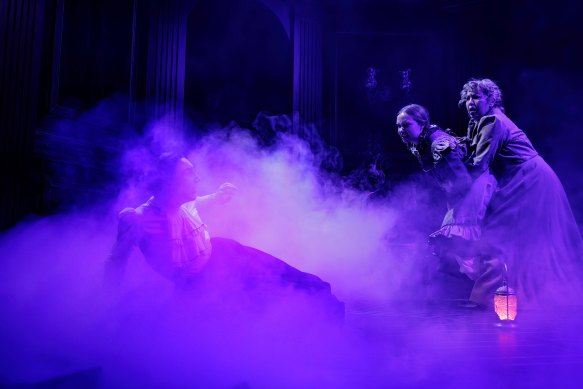
THEATRE
The Turn of the Screw ★★★½
Seymour Centre, until August 12
Fear turns to terror when our imaginations go to work upon the facts, as Henry James understood so well. By not explaining the ghostly phenomena in The Turn of the Screw, he engaged his readers’ imaginations, and by keeping the ambiguities alive until the end, he made a little masterpiece that readers keep reading, academics keep interpreting, and other artists keep adapting.

Lucy Lock, Kim Clifton and Martelle Hammer star in a new adaptation of Henry James’ gothic novella.Credit: Phil Erbacher
Writer-director Richard Hilliar is the latest to adapt the novella in this Tooth and Sinew production. In a program note, he speaks of embracing the story’s “utter commitment to ambiguity”, and he certainly does that in the first half, when the tension builds slowly, but inexorably.
This is as the governess (Lucy Lock) comes to suspect that her young charges, Flora (Kim Clifton) and Miles (Jack Richardson), might be hiding something sinister from herself and the housekeeper, Mrs Grose (Martelle Hammer).

The performances in The Turn of the Screw are matched by the production value.Credit: Phil Erbacher
In the second half, however, this commitment to ambiguity – essentially whether the ghosts are real or the governess’s hallucinations – unravels somewhat when some bouts of hysteria suggest the children might be possessed. Gulp.
Essentially Hilliar has taken James’ setting (a country house in 19th-century Essex), his mood (gothic) and his story-shape (suspenseful), and then fiddled with the precise incidents. Had he fiddled less in the finale, he would have done his play a favour.
Nonetheless, this is mostly a gripping piece of theatre. The first half flies by while one is still entranced by the nuances of the characters and performances.
Initially Hilliar has Lock present a less formal incarnation of the governess as she accepts the job from the children’s uncle (Harry Reid), but the characterisation settles as she bonds with her charges, and forms a wary friendship with Mrs Grose.









 Add Category
Add Category